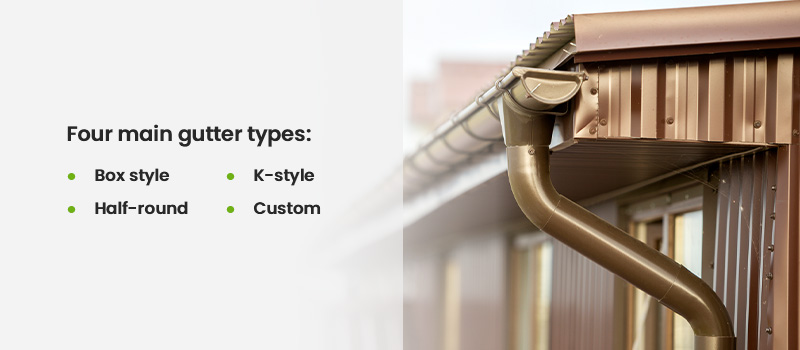Gutters work year-round to divert water away from your home. Without gutters, water would pool on your roof and against your foundation, weakening them and leading to mold, rot and expensive damages. Quality, well-fitting gutters will hold up well against the elements and provide you with years of water diversion.
If you’re wondering how to choose the right gutters, check out this guide that looks at the types of gutters and costs, materials and more. Understating the basics of gutters will help you find the right option for your home’s needs.
How to Choose the Right Gutters
With dozens of modern gutter styles and options, how do you pick the right one for your home? Gutters typically last 15 to 20 years. Their life span is influenced by type, material, use and care, but you can purchase higher-quality gutters that last longer. If it’s time to replace your gutters, consider these factors to get quality gutters that fit your needs and work well with your home:
- Type: Your gutter’s style will influence its look. Different gutter styles complement different home styles — their shape, lines, and color all work together to build each gutter type. Additionally, gutter type affects their drainage and cleaning schedule. Some gutter types clog more easily than others. The more customized your gutter, the more of an investment it will be.
- Size: You need a gutter size that fits your home. They won’t fit right in your house if they’re too big. If they’re too small, they won’t drain water correctly. Pick your gutter size based on your home’s fascia — consult professionals to help you get the right size.
- Material: Materials influence your gutter cost and life span. Each material has different benefits, colors, looks, costs and installation needs. Pick a material that complements your home and holds up to weather and wear.
- Cost: Cost is a significant factor for many homeowners. You need to consider initial, maintenance and replacement costs when looking for types of gutters. Investing in higher-quality gutters can save you costs down the road with increased durability.

Gutter Types and Sizes
There are several types of guttering profiles. Each type looks slightly different and offers benefits and drawbacks depending on your home and needs. Gutters most commonly come in sizes ranging from 4 to 6 inches, but you can get custom options outside of the standard sizing range. Your gutter style will influence your home’s look, the gutter’s durability and its cost.
Here are the four main gutter types:
- Box style: Box-style gutters have an oversized and boxy shape that may make them less appealing for some residential homes. They’re more common on industrial and commercial buildings since they’re larger than residential styles and less aesthetically appealing. Box gutters are installed when the building is built — they aren’t hung on the roof. Instead, they’re tucked under the roof’s shingles.
- Half-round: Half-round gutters are a vintage gutter style that you mainly see on older homes. Half-round gutters look like half a circle, with the top open to collect water. These gutters usually come in copper, but you can also select steel, aluminum or vinyl for your gutters. Brackets are used to install these gutters. Half-round gutters are completely smooth inside, making them less likely to rust, corrode or clog. They are less durable than K-style gutters and more expensive to install.
- K-style: These are the most common modern gutter style. They look like crown molding, which makes them complement your home’s design well. They’re highly affordable and easy to install. Their rigid “K” shape makes them more durable than half-round gutters. While K-style gutters are more durable than half-rounds, they’re also more likely to clog and corrode without proper maintenance.
- Custom: Custom gutter options are the least common and most expensive gutter style. These gutters are built and installed for your specific home. They’re much more expensive than half-round and K-style gutters, and they require professional installation and maintenance.
Gutter Materials
You’ll see several gutter material options when looking for new gutters. Choose a material that holds up well and makes gutter maintenance easy for a safer, cleaner home exterior. Let’s look at the materials you’re most likely to see:
- Vinyl: Vinyl is the least expensive gutter material. It’s lightweight, paintable and easy to install. However, it won’t last as long as other materials and is prone to fading. Since they’re vinyl, they won’t corrode or rust. Vinyl is an affordable gutter material with lower durability.
- Aluminum: With multiple thickness options, good durability and excellent weatherproofing, aluminum is the most popular gutter material choice. Thinner aluminum can dent or bend more easily, but thicker aluminum gutters withstand heavier snowfalls. Like vinyl, they’re easy to install.
- Steel: Steel gutters are more durable than aluminum and hold up well against severe weather. However, they are prone to rust, even when galvanized. They’re strong and can be painted. Stainless steel gutters avoid rusting but are more expensive.
- Zinc: Zinc is one of the more expensive gutter materials. If you are somewhere with no salty air, you can expect your zinc gutters to last a long time. While they won’t warp, fade or rust, they will develop a patina as time passes. These are durable but expensive gutter options.
- Copper: Copper is the most expensive gutter material. It’s highly durable and gives your home an attractive, vintage look. With proper maintenance, they’ll last over 50 years on your home. They’ll turn slightly green over time but won’t rust or warp. Copper is typically used in the most costly home gutter projects.
Cost of Gutter Installation
Gutter installation has several costs associated with it. Material, type, installation and footage all affect the gutter installation’s end price. Some gutter materials are more expensive than others, but this can come with increased durability and aesthetic benefits. Here are some of the factors that will influence the total cost of your gutter installation:
- Gutter: The material isn’t the only thing that affects gutter cost. Customization also affects the cost. The more custom your gutter style and material, the more expensive your gutters will be.
- Home: The larger your home and the more difficult it is to install your gutters, the more of an investment they’ll be. More gutter material and customization mean higher costs and higher specialization. It will cost more if you want highly-custom gutters for a larger home.
- Installation: Do-it-yourself installation sometimes costs less than professional installation. However, you might pay even more for professional repair and installation if something goes wrong when you DIY your gutters. Getting a professional job is safer and more reliable — they know what they’re doing and are less likely to cause damage. Getting installation done or needing DIY work corrected will add to the total gutter cost.

Choose A Better Gutter Cleaning for Your Gutter Needs
If you’re seeking high-quality gutter services in Atlanta, turn to A Better Gutter Cleaning. ABGC is unmatched in quality, customer service, reliability and speed. Our gutter replacement and installation services provide you with durable, attractive gutters for your home. From installation to gutter cleaning, repairs and protection, your home is in safe hands when you work with our expert team.
If you’re interested in affordable, dependable gutter services, contact us online to get your quote today.












